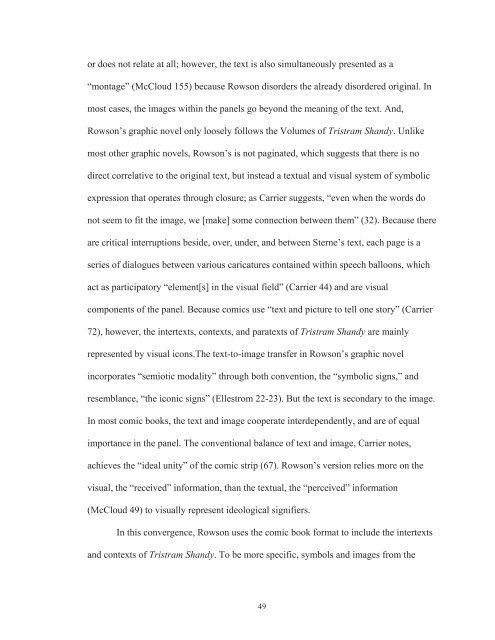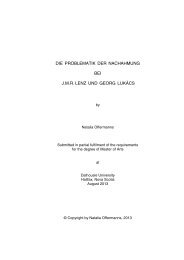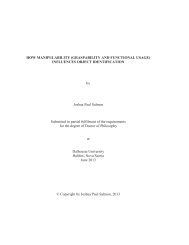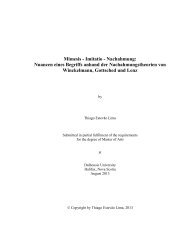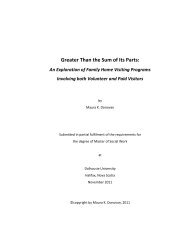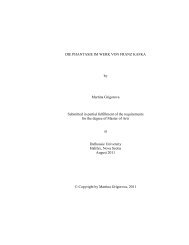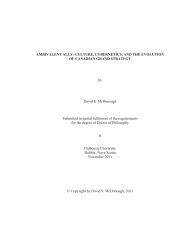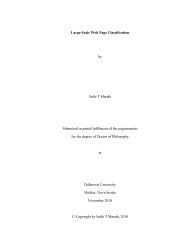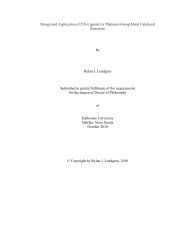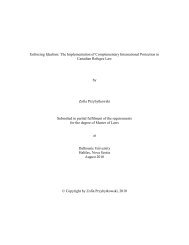ADAPTING TRISTRAM SHANDY by Adria Young Submitted in ...
ADAPTING TRISTRAM SHANDY by Adria Young Submitted in ...
ADAPTING TRISTRAM SHANDY by Adria Young Submitted in ...
You also want an ePaper? Increase the reach of your titles
YUMPU automatically turns print PDFs into web optimized ePapers that Google loves.
or does not relate at all; however, the text is also simultaneously presented as a<br />
“montage” (McCloud 155) because Rowson disorders the already disordered orig<strong>in</strong>al. In<br />
most cases, the images with<strong>in</strong> the panels go beyond the mean<strong>in</strong>g of the text. And,<br />
Rowson’s graphic novel only loosely follows the Volumes of Tristram Shandy. Unlike<br />
most other graphic novels, Rowson’s is not pag<strong>in</strong>ated, which suggests that there is no<br />
direct correlative to the orig<strong>in</strong>al text, but <strong>in</strong>stead a textual and visual system of symbolic<br />
expression that operates through closure; as Carrier suggests, “even when the words do<br />
not seem to fit the image, we [make] some connection between them” (32). Because there<br />
are critical <strong>in</strong>terruptions beside, over, under, and between Sterne’s text, each page is a<br />
series of dialogues between various caricatures conta<strong>in</strong>ed with<strong>in</strong> speech balloons, which<br />
act as participatory “element[s] <strong>in</strong> the visual field” (Carrier 44) and are visual<br />
components of the panel. Because comics use “text and picture to tell one story” (Carrier<br />
72), however, the <strong>in</strong>tertexts, contexts, and paratexts of Tristram Shandy are ma<strong>in</strong>ly<br />
represented <strong>by</strong> visual icons.The text-to-image transfer <strong>in</strong> Rowson’s graphic novel<br />
<strong>in</strong>corporates “semiotic modality” through both convention, the “symbolic signs,” and<br />
resemblance, “the iconic signs” (Ellestrom 22-23). But the text is secondary to the image.<br />
In most comic books, the text and image cooperate <strong>in</strong>terdependently, and are of equal<br />
importance <strong>in</strong> the panel. The conventional balance of text and image, Carrier notes,<br />
achieves the “ideal unity” of the comic strip (67). Rowson’s version relies more on the<br />
visual, the “received” <strong>in</strong>formation, than the textual, the “perceived” <strong>in</strong>formation<br />
(McCloud 49) to visually represent ideological signifiers.<br />
In this convergence, Rowson uses the comic book format to <strong>in</strong>clude the <strong>in</strong>tertexts<br />
and contexts of Tristram Shandy. To be more specific, symbols and images from the<br />
49


